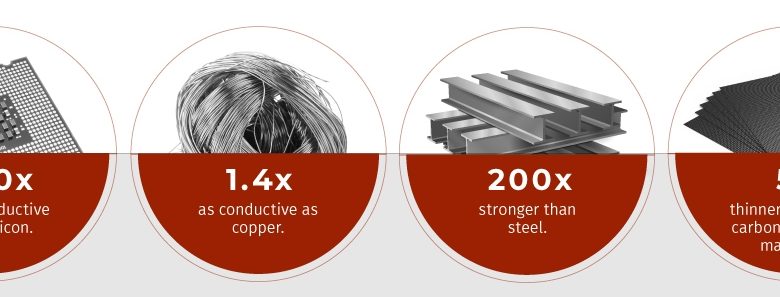
Graphene’s Semiconductor Missed Potential
Graphene has long been considered a miracle material, with exceptional characteristics that may play a role in next-gen semiconductors. Its perception as a miracle material is multipronged due to its physical characteristics, as it is 200x stronger than steel, and its electron mobility is 140x faster in graphene than in silicon.
İçindekiler
Source: Visual Capitalist
At first, researchers studying graphene thought it could replace silicon in semiconductors. Unfortunately, it misses a key electronic feature called a “band gap.”
A band gap is what determines if a material will be considered a metal (conducting electricity), an isolator (blocking electricity), or a semiconductor (that can switch between being conductive and isolant).

Source: Energy Education
The problem is that graphene has no band gap at all, preventing its use as a semiconductor.
However, another material type could have the same electron mobility as graphene but display a band gap compatible with semiconductor capabilities. This material is called an organic polymer.
Building Organic Semiconductors
What makes graphene so conductive are two factors:
- It is essentially a 2D material, forming a perfectly flat monoatomic layer of carbon atoms.
- The electrons between the hexagons of carbon can flow almost freely between the atomic structures called aromatic hydrocarbons.

Source: Britannica
Aromatic hydrocarbons are actually very common in nature, but the 2D layer of graphene is a lot more rare. However, many organic materials do have the potential to display the band gap that is missing in graphene.
Researchers at South Korea’s Pohang University of Science and Technology (POSTECH) Pr. Kimoon Kim, Pr. Ji Hoon Shim, Pr. Jun Sung Kim, and Dr. Yeongsang Lee looked for a way to turn ordinary organic material into something similar to graphene.

Source: POSTECH
Making Organic Polymers 2D
What prevents organic polymers from working as graphene is that during their polymerization, inter-layer stacking blocks the polymer’s growth.
The researchers found that by adding chemical groups blocking the attachment of monomers (steric hindrance), they could suppress the stacking of two-dimensional polymer intermediates. The organic polymer used was triazacoronene.

Source: POSTECH
They then added to the polymer synthesis a step called p-type doping, commonly used in the production of semiconductors. This refers to adding elements to a semiconductor material to make it even more conductive.

Source: Wikipedia by
The resulting material has been described by the researchers as having “outstanding electrical conductivity”.
The Massive Potential of Organic Semiconductors
This achievement solves the issue of organic semiconductors having too low electron mobility.
It also makes it easier to control the conduction pathways for electrons and holes at the molecular level, a necessary step for making transistors and computing chips out of this material.
It is also possible that graphene could be “given” a band gap, another path explored in further detail in our article “Graphene Semiconductors – Are They Finally Here?”.
Both the potential of graphene semiconductors and organic semiconductors with graphene-like specs could have many possible applications.
Of course that is only if we keep computing based on semiconductors, instead of photonics as discussed in “Advancing Semiconductors – Could ‘Donut’ Beams to ‘Lego’ Blocks Be Set to Upend Industry Approaches?” or quantum computing as discussed in “The Current State of Quantum Computing”.
Semiconductors
While silicon is reaching a limit due to its physical characteristics, graphene-like conductivity could make organic semiconductors a viable replacement material to keep Moore’s law valid, because faster electrons convert into faster computing.
This adds organic material to the candidates for replacing silicon, together with improved graphene and Insulator-To-Metal (IMT) like vanadium dioxide (you can read more about these semiconductor technology advancements in “Keeping Pace with Moore’s Law with Active Substrates And Neuromorphic Computing”).
Batteries
Another industry that is looking at using organic material to replace metals is the battery industry, which is powercharged by the boom in EVs and renewables.
If organic materials can display graphene-like properties, they could be an option for graphene batteries, one of the many possible EV battery chemistry, which we discussed in “The Future of Mobility – Battery Tech”.
Semiconductors Companies
1. IBM
A historical pioneer in computing, semiconductors, and chip design, International Business Machines Corporation (IBM) has been present in most of the cutting-edge innovations in computing and the semiconductors industry.
This includes conducting organic materials as discussed in this article, but also neuromorphic computing, quantum computing, photonics, etc.

Together with Intel, IBM is among the companies most aggressively pushing for new forms of computing technologies, looking to replicate non-silicon computing and its past successes.
This puts IBM in a good position to leverage its massive R&D budget and network of research partners to exploit discoveries like graphene-like organic semiconductors.
2. ON Semiconductor Corporation
ON Semi is a semiconductor company specializing in electrification, including in automotive, but also in other sectors like solar energy, batteries, aerospace, telecommunication, data centers, and medical. As such, it is a key partner for many of the largest industrial companies in the world.

Source: ON Semi
A big part of ON Semi’s technological advantage is based on silicon carbide, a type of silicon-carbon compound used for high-energy electric systems. They notably allow for very high power loads required for the fast charging of EVs.
Silicon carbide is the chemical used recently by researchers to develop semiconductive graphene, as discussed in our article “Graphene Semiconductors – Are They Finally Here?”.
ON Semi’s strategy of doubling down on silicon carbide led to the company experiencing a surge in revenues in the last few years, carried by the EV revolution.
The expertise of ON Semi in silicon carbide and generally semiconductors using carbon could be precious in industrializing semiconductors based on either graphene or organic materials.
In the meantime, the need for ever more powerful and efficient batteries and electric systems, silicon carbides, are becoming increasingly important in the global supply chain. As a leader in the sector, ON Semi will likely benefit greatly from the electrification trend, especially EVs.
Finally, it is also possible that if organic semiconductors have applications in battery technology, ON Semi’s strong presence in the sector could help it be one of the first companies in a position to deploy this technology.